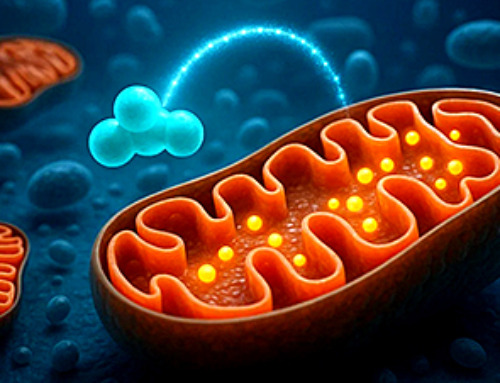When we need to recharge, we might take a vacation or relax at the spa. But what if we could recharge at the cellular level, fighting against aging and disease with the microscopic building blocks that make up the human body?
The ability to recharge cells diminishes as humans age or face diseases. Mitochondria are central to energy production. When mitochondrial function declines, it leads to fatigue, tissue degeneration, and accelerated aging. Activities that once required minimal recovery now take far longer, highlighting the role that these organelles play in maintaining vitality and overall health.
While current treatments for ailments related to aging and diseases like type 2 diabetes, Alzheimer’s, and Parkinson’s focus on managing symptoms, Texas A&M researchers have taken a new approach to fight the battle at the source: recharging mitochondrial power through nanotechnology.
Led by Dr. Abhay Singh, a biomedical engineering postdoctoral associate in the Gaharwar Laboratory at Texas A&M, the team has developed molybdenum disulfide (MoS₂) nanoflowers. Named because of their flower-like structure, these nanoparticles contain atomic vacancies that can stimulate mitochondrial regeneration, helping cells generate more energy.
The team published their findings in Nature Communications.
“These findings offer a future where recharging our cells becomes possible, extending healthy lifespans, and improving outcomes for patients with age-related diseases,” said Dr. Akhilesh Gaharwar, Tim and Amy Leach Professor and Presidential Impact Fellow in the Department of Biomedical Engineering at Texas A&M.

According to Gaharwar, the nanoflowers could offer new treatments for diseases like muscle dystrophy, diabetes, and neurodegenerative disorders by increasing ATP production, mitochondrial DNA, and cellular respiration. They discovered that the atomic vacancies in the nanoflowers stimulate the molecular pathways involved in mitochondrial cell replication.
Research collaborators include Texas A&M faculty and students. From the Department of Biophysics and Biochemistry, Dr. Vishal Gohil provided insights into the mechanisms that could drive the improvement of mitochondrial function.
“This discovery is unique,” Dr. Gohil said. “We are not just improving mitochondrial function; we are rethinking cellular energy entirely. The potential for regenerative medicine is incredibly exciting.”
Other Department of Biomedical Engineering contributors include Dr. Hatice Ceylan Koydemir, assistant professor, and Dr. Irtisha Singh, an affiliate assistant professor in the Department of Molecular and Cellular Medicine. Singh contributed computational analysis that revealed key pathways and molecular interactions responsible for the energy boost.
“By leveraging advanced computational tools, we can decode the hidden patterns in cellular responses to these nanomaterials, unlocking new possibilities for precision medicine,” Singh said. “It’s like giving cells the right instructions at the molecular level to help them restore their own powerhouses—mitochondria.”
The next steps for the research team include identifying a method for delivering the nanoflowers to human tissue, with the goal of eventual clinical application.
“In science, it’s often the smallest details that lead to the most profound discoveries,” Gaharwar said. “By focusing on the unseen—like atomic vacancies in nanomaterials—we are uncovering new ways to solve big problems. Sometimes, the real breakthroughs come from digging deeper and looking beyond the obvious.”
More information: Kanwar Abhay Singh et al, Atomic vacancies of molybdenum disulfide nanoparticles stimulate mitochondrial biogenesis, Nature Communications (2024). DOI: 10.1038/s41467-024-52276-8
Journal information: Nature Communications
News
Breakthrough Drug Restores Vision: Researchers Successfully Reverse Retinal Damage
Blocking the PROX1 protein allowed KAIST researchers to regenerate damaged retinas and restore vision in mice. Vision is one of the most important human senses, yet more than 300 million people around the world are at [...]
Differentiating cancerous and healthy cells through motion analysis
Researchers from Tokyo Metropolitan University have found that the motion of unlabeled cells can be used to tell whether they are cancerous or healthy. They observed malignant fibrosarcoma cells and [...]
This Tiny Cellular Gate Could Be the Key to Curing Cancer – And Regrowing Hair
After more than five decades of mystery, scientists have finally unveiled the detailed structure and function of a long-theorized molecular machine in our mitochondria — the mitochondrial pyruvate carrier. This microscopic gatekeeper controls how [...]
Unlocking Vision’s Secrets: Researchers Reveal 3D Structure of Key Eye Protein
Researchers have uncovered the 3D structure of RBP3, a key protein in vision, revealing how it transports retinoids and fatty acids and how its dysfunction may lead to retinal diseases. Proteins play a critical [...]
5 Key Facts About Nanoplastics and How They Affect the Human Body
Nanoplastics are typically defined as plastic particles smaller than 1000 nanometers. These particles are increasingly being detected in human tissues: they can bypass biological barriers, accumulate in organs, and may influence health in ways [...]
Measles Is Back: Doctors Warn of Dangerous Surge Across the U.S.
Parents are encouraged to contact their pediatrician if their child has been exposed to measles or is showing symptoms. Pediatric infectious disease experts are emphasizing the critical importance of measles vaccination, as the highly [...]
AI at the Speed of Light: How Silicon Photonics Are Reinventing Hardware
A cutting-edge AI acceleration platform powered by light rather than electricity could revolutionize how AI is trained and deployed. Using photonic integrated circuits made from advanced III-V semiconductors, researchers have developed a system that vastly [...]
A Grain of Brain, 523 Million Synapses, Most Complicated Neuroscience Experiment Ever Attempted
A team of over 150 scientists has achieved what once seemed impossible: a complete wiring and activity map of a tiny section of a mammalian brain. This feat, part of the MICrONS Project, rivals [...]
The Secret “Radar” Bacteria Use To Outsmart Their Enemies
A chemical radar allows bacteria to sense and eliminate predators. Investigating how microorganisms communicate deepens our understanding of the complex ecological interactions that shape our environment is an area of key focus for the [...]
Psychologists explore ethical issues associated with human-AI relationships
It's becoming increasingly commonplace for people to develop intimate, long-term relationships with artificial intelligence (AI) technologies. At their extreme, people have "married" their AI companions in non-legally binding ceremonies, and at least two people [...]
When You Lose Weight, Where Does It Actually Go?
Most health professionals lack a clear understanding of how body fat is lost, often subscribing to misconceptions like fat converting to energy or muscle. The truth is, fat is actually broken down into carbon [...]
How Everyday Plastics Quietly Turn Into DNA-Damaging Nanoparticles
The same unique structure that makes plastic so versatile also makes it susceptible to breaking down into harmful micro- and nanoscale particles. The world is saturated with trillions of microscopic and nanoscopic plastic particles, some smaller [...]
AI Outperforms Physicians in Real-World Urgent Care Decisions, Study Finds
The study, conducted at the virtual urgent care clinic Cedars-Sinai Connect in LA, compared recommendations given in about 500 visits of adult patients with relatively common symptoms – respiratory, urinary, eye, vaginal and dental. [...]
Challenging the Big Bang: A Multi-Singularity Origin for the Universe
In a study published in the journal Classical and Quantum Gravity, Dr. Richard Lieu, a physics professor at The University of Alabama in Huntsville (UAH), which is a part of The University of Alabama System, suggests that [...]
New drug restores vision by regenerating retinal nerves
Vision is one of the most crucial human senses, yet over 300 million people worldwide are at risk of vision loss due to various retinal diseases. While recent advancements in retinal disease treatments have [...]
Shingles vaccine cuts dementia risk by 20%, new study shows
A shingles shot may do more than prevent rash — it could help shield the aging brain from dementia, according to a landmark study using real-world data from the UK. A routine vaccine could [...]





















